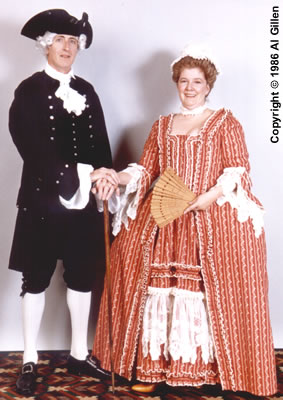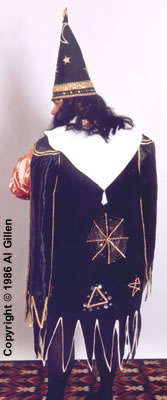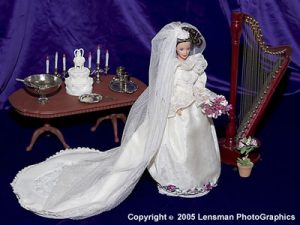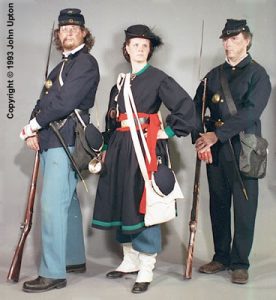CC04-H-06b: A Medi Conjurer (1500s)
Competition Staff & Rules
Staff:
- Masquerade Director: Victoria Ridenour
- Master of Ceremonies: Will Bonner
- Presentation Judges: Adrian Butterfield‡, Rosemary Bonner, Carolyn Kayta Martz‡
Rules:
The Costume-Con Historical Masquerade will be presented Sunday night at 7:30 p.m., in The International Ballroom. Registration forms will be available at the convention registration table. Please fill them out and turn them in by 3:00 p.m. Sunday, along with any cassette tape you wish played. At this time you will be given a specific time at which to show up for the backstage judging. This is when you should present all of the documentation that is outlined below.
PLEASE NOTE THAT THE RULES AND REGULATIONS GOVERNING PRESENTATIONS, LABELLING OF TAPES, TIME LIMITS, AND WEAPONS THAT APPLY TO THE SCIENCE FICTION AND FANTASY MASQUERADE ALSO APPLY TO THE HISTORICAL MASQUERADE.
DIVISIONS – As in the SF Masquerade, the division system will prevent a first timer from having to compete with a seasoned master.
NOVICE – A person with no previous award at any competition; a first entry in a historical competition with some experience in another field of costuming or first entry in any competition.
JOURNEYMAN – A costumer who has won major awards in another field of costuming but with little or no experience in historical costuming; has taken a novice award at a previous Costume-Con Historical Masquerade; an historical costumer with no professional or major awards in previous historical masquerades.
MASTER – Historical costuming experience, professional jobs and major awards at historical competitions.
Pick the division you feel most comfortable with. If you have any questions, ASK!
CATEGORIES – The Historical Masquerade will include but is not limited to the following categories.
Within each category you will be judged according to the following criteria, as applicable. The object is not to score high points in all categories. For example, an exact copy of Marie Antoinette’s dress will score high in authenticity but low in creativity. An original design may score well in creativity and yet low in authenticity. Remember, it is the overall effect that counts the most.
HISTORICAL INTERPRETATIONS – We have seen an increasing number of these recently. These costumes are not being approached as reproduction clothing but rather as an imaginative spin-off based on a historical premise. This could range from a wild west scenario to living art-nouveau posters. On stage performance has figured heavily in this type of presentation.
MOVIE REPRODUCTIONS – A rich source for imaginative costumers to show off their technical skills. We would like to point out that the judges will be looking for hair, makeup and construction techniques for the year the movie was made rather than the era in which the movie is set. How often have we seen a Renaissance story done in a 1940’s costumers vision of history. You can see the challenge this type of entry presents; it can be gangs of fun!
HISTORICAL REPRODUCTIONS – Carefully documented and researched, patterned, sewn and presented with period mannerisms in mind, these are a piece of living history. It ranges from the menial worker to the nobility, all a challenge.
None of these categories will compete against one another, none favored, and if one entry merits a Best in Show, it could come from any category.
JUDGING CRITERIA – In picking judges and setting up judging criteria, we have been consulting experts in many fields of historical costuming to draw from their expertise.
Each entry will be judged on its own merit and within its own division. As you read these criteria, you will find they apply to almost all types of costuming including fantasy and science fiction.
DOCUMENTATION – This is important to both entrant and judge, as not everyone is an expert in all eras and countries. An esoteric entry can receive the recognition it deserves by presenting it with detailed documentation.
Your documentation will be judged as follows:
0 – No documentation or very inaccurate.
1 – Minimum information listing time, place and pattern source.
2 – Same as 1 with xeroxes but no additional detail.
3 – Same as 1 with additional detail including, at least, specified examples; primary sources, if available, and rationale for fabric, color and design of major elements of garment and construction.
4 – Same as 3 plus rationale for all elements of the costume, including minor details; a display of understanding of general style of the period represented; explanation of any deviations from the period norm.
CREATIVITY – A different type than that for the fantasy costumer comes into play in the historical masquerade. Rather than relying on a purely original premise, historical costuming has its own foundation for interpretive spin-offs.
0 – An exact copy from a modern source like Folkwear Patterns.
1 – A standard style for the period, mostly copied from a familiar source like The Evolution of Fashion.
2 – Logical combinations of period elements, taken from various sources,
3 – Individual interpretations, logical to the period.
4 – Innovative combination of elements, logical to a single period; looks as if it was done by a creative historical designer.
AUTHENTICITY – This will be judged to the degree the entrant wishes to be judged. Reproductions of clothing striving for accuracy will be carefully examined in a prejudging session before the masquerade so that details of garments which may be lost on stage will receive recognition. On the same note, interpretive categories need not be judged “from the skin out”. That is not necessarily the point of this category.
0 – Blatantly modern.
1 – Period elements incorrectly combined. (i.e., inappropriate mix of time and culture.)
2 – Looks authentic on surface, but has inauthentic elements in design, color, fabric, etc. (“Theater costume”)–e.g., fake underlayers.
3 – Authentic in look and feel; attempt to reproduce original fabrics and imitate period techniques.
4 – Above plus special effort to achieve total period effect; e.g., all hand sewn, hand done embellishment, accessories made by the entrant, presented with movement and manners correct for the period.
WORKMANSHIP – This applies to any entry. Quality is quality, no matter what the category and a beautiful job deserves recognition.
The success of the attempt in each of the following categories will be ranked from 0-6. Add these scores and divide by 4 for the overall workmanship score.
- Technical – Seam finishing, stitching, neatness.
- Fit – Does it hang correctly; move and fit appropriate to the period and style?
- Handling of fabric – Choice, use of nap, print, bias, etc. Construction details – Interfacing, smocking, pleating details, linings, etc., as appropriate.
COMPLEXITY – This applies to the scope of the project attempted rather than the workmanship.
You will be judged on a scale of 0-6 in each of the following categories. Then add the scores and divide by 4.
- Scope of project – The number of pieces, size in relation to detail, etc.
- Variety of techniques used
- Difficulty of techniques attempted
- Extent of original pattern used
OVERALL OBSERVATION – You will be scored on a scale of 0-6 on how well all these separate elements work together.
We hope these rules will clarify the intent of the Historical Masquerade. Ultimately, the idea is to have fun and bestow recognition on the consistently fine work presented at the Costume-Con Historical Masquerade.




